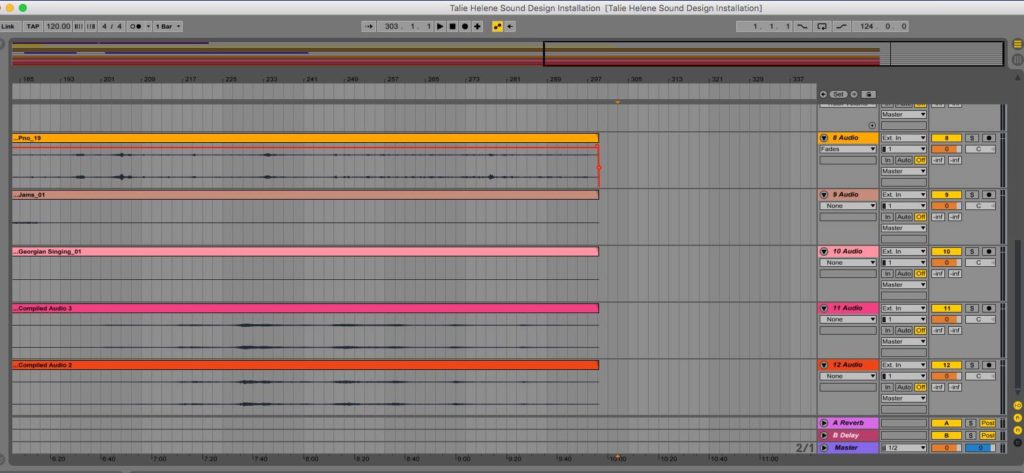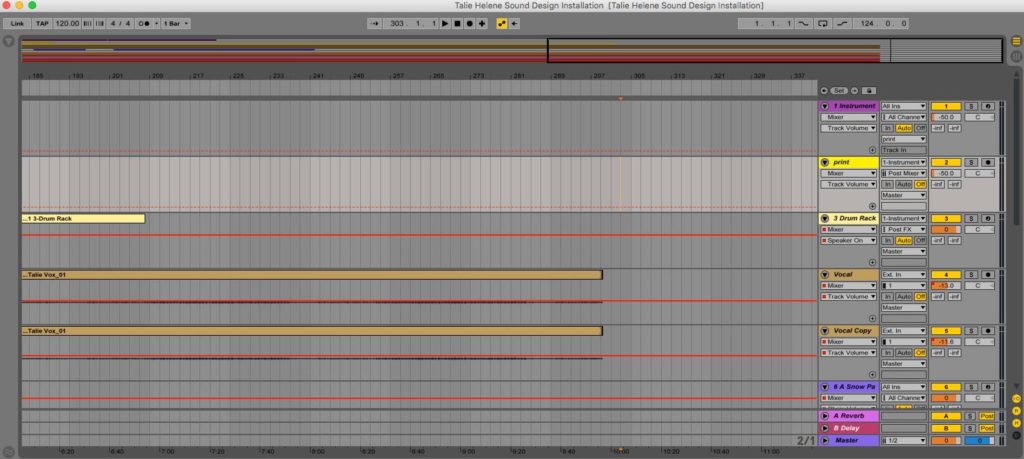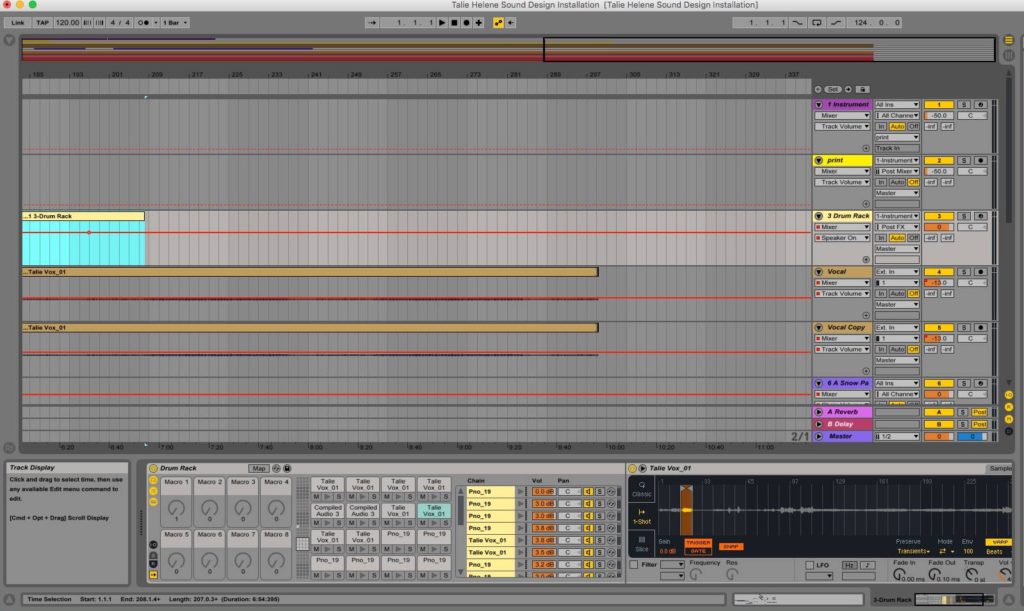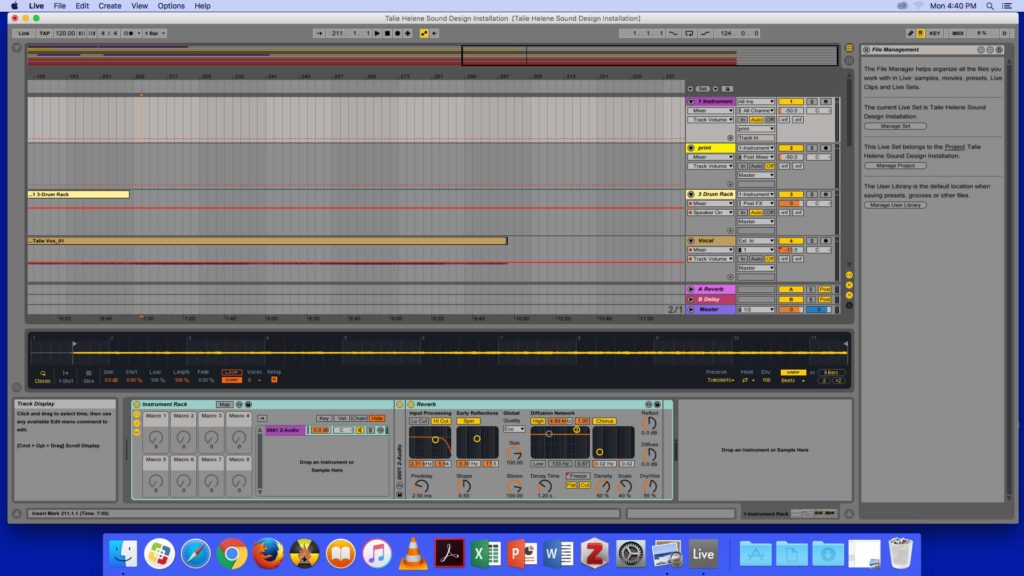Sound Installation Sound Design Project
This project was undertaken as coursework for assessment in the ‘CUASOU503 Develop Sound Designs’ Unit of Competancy, as part of the Advanced Diploma of Music Industry qualification at Melbourne Polytechnic.
The UnVoice In Campus Sounds
For this project we needed to create a Sound Installation in Ableton using “campus sounds” framed by a concept, narrative, idea or theory. I decided to play with the notion of the voices of the campus – including the UnVoice or the Uncanny Voice of the campus, with a speculative fiction idea of voices of the place (a former hospital) resonating both forwards and backwards in time – ghosts of the future and ghosts of the past.
In her book ‘Voicetracks: Attuning to Voice in Media and the Arts’ (MIT Press. Cambridge, Massachusetts, 2017.), sound artist and academic Professor Norie Neumark poses the idea of the unvoice, of unvoicing, of being unvoiced. (My WordPress autocorrect keeps changing the words to unveiled and unveiling, which is poignant to the visibility of women.)
“The figure unvoice … particularly speaks to me because it evokes an … un quality of voice, its uncanniness – the return of the undead? As writer and scholar Mark Fischer, aka k-punk, points out, the Derridean figure of haunting and the uncanny (unheimlich) resound together: “Haunt is a perfectly uncanny word, since like ‘unheimlich’ it connotates both the familiar-domestic and its unhomely double. Haunt originally meant ‘to provide with a home,’ and has also carried the sense of the ‘habitual’ (k-punk, 2006). In this sense, unvoice literally haunts its media, a reminder of how we habitually used to listen to a relationship that is no longer at ease here – uneasy as well as uncanny.” [1]Neumark, Norie. ‘Voicetracks: Attuning to Voice in Media and the Arts’, MIT Press, Cambridge, Massachusetts, 2017.
For my Sound Design Installation I decided to play with the permeable nature of memory and time and the notion of extra-sensory perception of the dying or the delirious and feverish and deeply troubled. While echoes of the past linger in the architecture – the quiet sad dereliction of the Aids Memorial Garden with the river bush sounds, the theatre that looks awfully like a crematorium and a morgue space, the awnings and doors clearly designed for ambulance use, the hospital squeak of the floors and the high gates with a gatehouse to secure every infectious patient from making a quite literal “outbreak” – and fill the present with reminders of mortality – what if these resonances also echoed backwards? The voices and music and overlapping din of practice rooms and studios and rehearsal spaces echoing back to the minds of the dying and fever-drenched who used to occupy these buildings?
A Sense of Place
Melbourne Polytechnic Fairfield Campus, where many of the music and sound production courses are based, is a beautiful campus set in seclusion and surprising isolation given the inner-suburban location. This is not an accident. The campus is the former location of the Fairfield Infectious Diseases Hospital, originally the Queens Memorial Infectious Diseases Hospital. The location between Merri Creek and the Yarra River creates natural barriers; one can only approach the campus on one road (unless using a bike or walking trail).
While there have been obvious efforts to mute the “institutional” hospital feel of the campus, at every turn in the architecture and fixtures (or places where fixtures used to be) the medical nature of the history linger. This creates a peripheral awareness of very different uses of the spaces, both in the comparative recent history in the 1980s and 1990s when HIV/AIDS research and treatment was a major undertaking at this facility and the title “Queen’s Memorial Hospital” was owned humorously by the community of patents [2]Fairfield Hospital, Under The Red Ribbon, http://undertheredribbon.com.au/vignettes/fairfield-hospital/ , and further into the distant past – from the Polio epidemics of the 1920s to 1950s, right back to the Spanish Infuenza epidemic of 1918.
People convalesced on the sheltered verandahs here. And people died painful deaths here. And people lingered in altered states of delirium and fever-dream. Right next door to this day, the southern part of the original hospital is still in use as The Victorian Institute of Forensic Mental Health, Thomas Embling Hospital – which treats the acutely mentally ill from the criminal justice system. There is a sense of over-lapping and parallel narratives, where very different modes of perception are unfolding.
And then there are the music students today filling the rooms and the outdoor environments with music and sound, overlapping different eras, echoing, resonating…
Source Recordings
I collected a range of different location recordings on campus, wondering about with a Tascam DR-100MKII Linear PCM Recorder and a Sennheiser ME66/K6 Supercardiod Shotgun microphone. The sounds I recorded included cafe sounds, sounds of the factory next door, traffic sounds on Yarra Bend Drive, sounds of the hospital-fitted air-conditioners, sounds of birds and of brushing past plants, sounds of horticulture students digging and shovelling, sounds of various rehearsals from the exterior of buildings (including Gamelan Ensemble, Georgian Choir, rock and pop ensembles). I also sourced sounds from studio recordings I had made within the campus, but made new and uncanny through processing – I made particular use of AudioSuite in Pro Tools 12 to process audio backwards. This was especially uncanny sounding on the Georgian Choir and Gamelan Ensemble recordings. The ideas of these inter-cultural sounds echoing back to a distant past where they had little context to frame them to ghosts of the past was a particularly romantic, ethereal and numinous notion.
I also included recordings of my own voice singing select phrases from the ghost ballad ‘The Unquiet Grave’ as I found it quite applicable to the theme and concept of Unvoice and Uncanny Voice, as well as the history of the Campus: how much human remains must linger in a place for it to be a grave? After attending Liquid Architecture/ the Melbourne International Film Festival event ‘Michel Chion: The Audio Spectator’ [3]Liquid Architecture, Michel Chion: The Audio Spectator, http://www.liquidarchitecture.org.au/program/michel-chion/ , and seeing and hearing how much of himself Michel Chion put into his sound art, I felt quite liberated to be a part of the work as one of the voices. I found the phrase “grow green, and spring up again” to be very evocative of the lushness of the carefully tended gardens here, and the creepy idea of voices or unvoices rising up like ghosts.
Initial Assemblage of Sound Collage
As I feel very “newb” and not skilled up in Ableton, I arranged elements and did some processing in Pro Tools 12, before exporting stems for import into Ableton.
MP3 of Partial Project, audio elements compiled in Pro Tools.
Constructing Instrument Rack and Drum Rack in Ableton
I then assembled my stems again in Ableton (this was only a partial success, due mostly to my still tentative skills using Ableton). The following two screenshots are of Ableton Session View of audio elements.


I created both an Instrument Rack and a Drum Rack as per our assessment brief requirements. I used the audio of various Campus Sounds elements from a Clip Library of original Sounds instead of “Loops” included with Ableton.


Once I had created the Instrument Rack and Drum Rack and included some processing, I played both of these “Live” and recorded the audio. This gives the Sound Installation a spontaneous and improvised quality. I very much treated this as an experiment, as I am learning about Ableton as an “instrument” each time I use it.
Unvoices of Yarra Bend
MP3 of final project:
In De-Brief
I did become slightly more proficient in using Ableton during this project, although I still identify many aspects where I am struggling to achieve even the most basic tasks of placing audio on a track (and Google the problem and get unhelpful advice or tutorials that require use as an Admin). It makes it hard to differentiate actual problems from mere logistics problems of using a lab computer, and I have not got a solid grasp of “Ableton 101” basics. For this reason, I applied to (and was accepted into) the Operator [4]Operator Event page, Arts Centre Melbourne, https://www.artscentremelbourne.com.au/event-archive/2017/the-channel/operator-ii short course at Arts Centre, which is affiliated with the Melbourne Ableton User Group. I have only attended one Operator class so far, but I am already beginning to appreciate some of the features that make Ableton unique – which also make it confusing and cumbersome if you come at it with the expectation that it is going to function like another DAW. I look forward to how my skills will be enhanced by taking a course more focused on basic Ableton operating skills, and where this may take my creativity in the future…
References
| ↑1 | Neumark, Norie. ‘Voicetracks: Attuning to Voice in Media and the Arts’, MIT Press, Cambridge, Massachusetts, 2017. |
|---|---|
| ↑2 | Fairfield Hospital, Under The Red Ribbon, http://undertheredribbon.com.au/vignettes/fairfield-hospital/ |
| ↑3 | Liquid Architecture, Michel Chion: The Audio Spectator, http://www.liquidarchitecture.org.au/program/michel-chion/ |
| ↑4 | Operator Event page, Arts Centre Melbourne, https://www.artscentremelbourne.com.au/event-archive/2017/the-channel/operator-ii |




 You can find out more about my creative activities at
You can find out more about my creative activities at 
Recent Comments